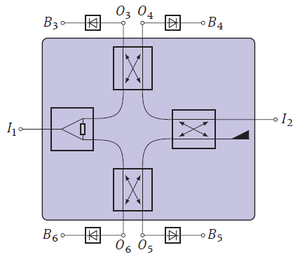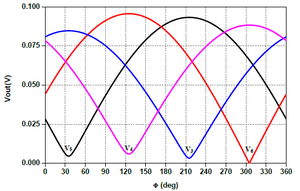Six-Port Radar
1 General Information
The Six-Port radar is a kind of radar that utilizes a specific principle (the so-called additive mixing property) of the Six-Port network. The Six-Port network was at the beginning developed to be used in a homodyne receiver. However, the principle can be applied to radar applications as well. The Six-Port network is a passive network consisting of six terminals, which are two input ports and four output ports. At the inputs, the two input signals are superimposed with each other under four different relative phase shifts. Depending on the phase difference and the amplitudes of the two input signals, constructive and destructive interaction takes place at the four output ports. A basic diagram of the Six-Port network is shown in Figure 1 [1]. Detailed mathematical analyses can also be found in [1]. A power divider is used to split the input power I1 to the two couplers, where the other inputs of them come from the other coupler that is interfaced with the input I2. The four DC voltages B3 to B6 are extracted from the four outputs O3 to O6 using envelope detectors. When plotted, the DC voltages B3 to B6 become quadrature function of the phase difference between I1 and I2, as shown in Figure 2.


